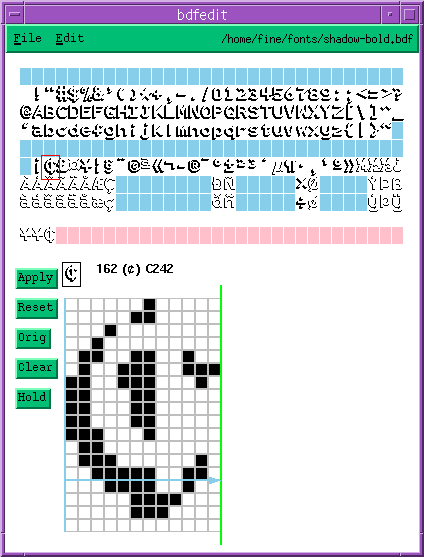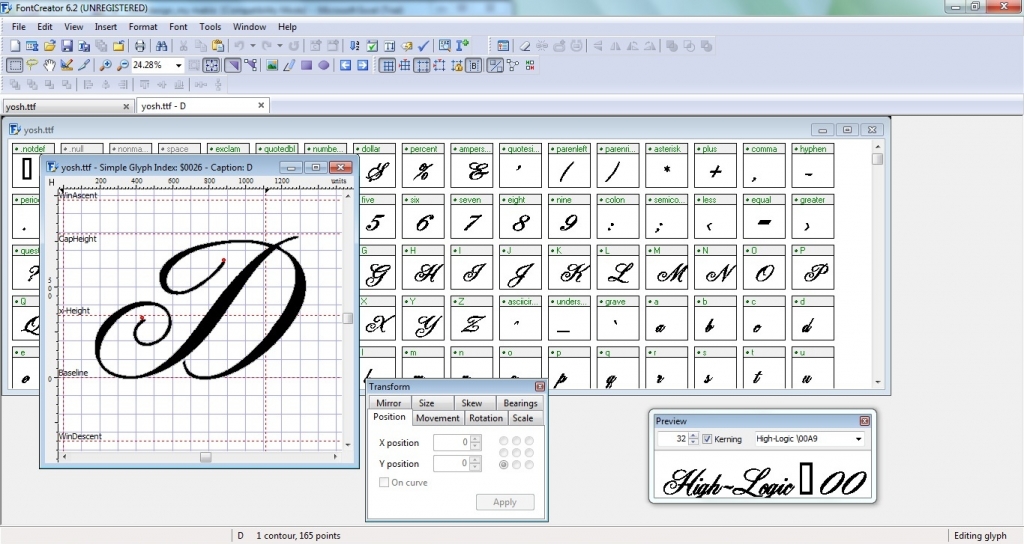
Export options
Private Rectangle GetConstrainedTextHeight(Font font, string textToParse, ref string resultText) // to ease typing, we set a local variable to the value specified in the // settings object int quoteAreaWidth = msaverSettings.QuoteAreaWidth; // create a new bitmap - I don't knowe if the size matters, but just to // be safe, I set it to be.
You can open the export options dialog by going to the Options menu and choosing Export options, or you can just press T on the keyboard.
- Glyph Designer is a powerful bitmap font designer. Create beautiful designs using highly configurable effects, definable backgrounds and more. Make the most of your screen with smart zooming and full screen support. Target hundreds of devices on multiple platforms with support for over 15 frameworks out the box.
- Pixel fonts, also known as screen fonts or bitmap fonts, are fonts consisting of small pixels. Pixel fonts display the texts in simple blocks instead of elaborate curves as most regular fonts do. So the obvious advantage of pixel fonts over regular fonts is that texts using pixel fonts can still look crisp and clear in very small sizes.
This dialog controls how the font will be stored, i.e. texture layout, file format, etc.

Padding
Padding is useful when you want to add some post processing effects in another paint program. For example, if you want to add a blurring effect that uses a 5x5 kernel,you would add a padding of 2 on all sides. Similarly if you want to add a drop shadow, youwould add a bit of padding below and to the right of the characters (assuming that's the direction of the drop shadow that you want).
Spacing
The spacing controls how much minimum space is left between characters in the font texture. If you're using mipmapping to scale the font texture when drawing the font, you'll need to add spacing to avoid bleeding when the texture is downscaled. The more mipmap levelsyou use the more spacing you need.
Bilinear filtering may also cause bleeding, so unless you use pixel perfect drawing, whereeach texel is perfectly mapped to a pixel on the screen with a 1-to-1 releation ship you'llwant to use at least 1 for vertical and horizontal spacing.
Equalize the cell heights
When this option is checked, all the font characters will be exported into cells of equal height. This option is especially useful when you workflow for producing the final font includes a post processing step where the characters are 'painted' based on the height of character, e.g. whenapplying a gradient.
The drawback is that less characters will fit in the texture, and the font renderer will draw largerrectangles.
Force offsets to zero
This option was created to improve support for font renderers that don't handle xoffset, yoffset, and xadvance. When the option is checked the glyph images will be padded so that xoffset and yoffset will be 0 and xadvance will be equal to the width. This option also forces the equalization of the cell heights.
Observe, that this will modify the final spacing between characters if the original TrueType font uses negative xoffsets, or xadvance that is smaller than the glyph width, i.e. if the characters have any overhang.
Texture
BMFont supports several different texture layouts. The width and height, of course controlthe size of the texture. You'll want to keep the texture as small as possible, while still allowing all characters to fit in one texture.
If you're importing colored icons, or planning on using post processing to add colors to thecharacters, then you'll want to choose the 32bit format, otherwise the 8bit format may be sufficient.
If you choose the 32bit format, you may still optimize the usage of the texture memory if youchoose to pack characters in each channel, though that will require a special pixel shader to decode during drawing. In this mode you can still import colored icons, the characters will beproperly packed around them.
The font outline can also be encoded together with the character in 8 bits, allowing you tostore many more characters in the same space than if you had stored the outlined characters ascolored images. This too require a special pixel shader to decode during drawing.
Channel options
Create A Color Bitmap Font, Step-by-step | Fontself Maker ...
- glyph : The channel will be set according to the glyph geometry. A value of 1 means the pixel is within the glyph.
- outline : The channel will be set according to the outline geometry. A value of 1 means the pixel is within the outline or glyph.
- glyph + outline : The value is encoded to allow separation of glyph and outline. A value of 0.5 means the pixel is within the outline, but not within the glyph. A value of 1 means the pixel is within the glyph.
- one : All pixels in the channel will be set to 1.
- zero : All pixels in the channel will be set to 0.
Some of the more common choices are:
- 32bit white glyphs with black outline: alpha = outline, red = green = blue = glyph
- 32bit white glyphs without outline: alpha = glyph, red = green = blue = one
- packed textures with glyph and outline encoded in 8 bits: alpha = glyph + outline
- packed textures with glyphs without outline: alpha = glyph
File format
Finally you can choose the file format for both the font descriptor and textures. This is mostlya matter of choice, rather than one having more benefits than the other. Though if you want to savedisc space, you may want to choose binary file descriptor with png textures.
Bitmap fonts are a great way to customize your novel's look and feel, but they can be quite tedious to produce manually.
Luckily there is a very good tool that makes it fast and easy and it's called Bitmap Font Generator, by Andreas Jönsson (www.AngelCode.com). The tool can generate a bitmap font in a format that Novelty is capable of importing.
BFG is included with Novelty, but if you want to get the latest version, read tutorials or just pay tribute to the developer you can visit the official site.
Using the Bitmap Font Generator
8 Bit Text Generator
BFG is very easy to use. You select a font that's on your computer and tweak the settings to fit your needs. In the case of unicode fonts you can pick which languages to include. The tool then generates the font as one or more texture-files and an FNT-file. The FTN-file holds all the information Novelty needs to find the characters in the textures.
Click Options->Font settings or press F to pick a font.
Most of the settings in this dialog are self-explanatory. If you want your font to include letters and signs from non-latin languages make sure to set the Charset to Unicode.
If you click Options->Expert options or press T you get treated to even more settings.
There are a couple of things here that you need to consider:
First and foremost you need to make sure that the Font descriptor is set to XML, as it's the only format that Novelty can interpret. You also need to make sure that the Bit depth is set to 32 or else your font won't have any transparency.
As for the texture size it depends on the size of the font. If the font can't fit within a texture, additional texture files will be generated. 512x512 is the recommended size.
To preview the font texture(s), click Options->Visualize
When you're happy with how it looks, save your font.
Once you've generated the texture(s) and FNT-file, you chould bring up Novelty. In the File-menu, select Import assets->Bitmap fonts...
This will bring up the bitmap font import wizard. Click Load font... and navigate to the FNT-file you just generated. Once that's done, you have the option to change the name and add a filter. Then click Import. This will copy the font XML and the texture(s) to Novelty's asset library.
See Full List On Angelcode.com
That's it. You should be ready to go. If you want, you can also save it as a package. The font will then be compressed to a single file that can be easily shared with friends.
Comments are closed.